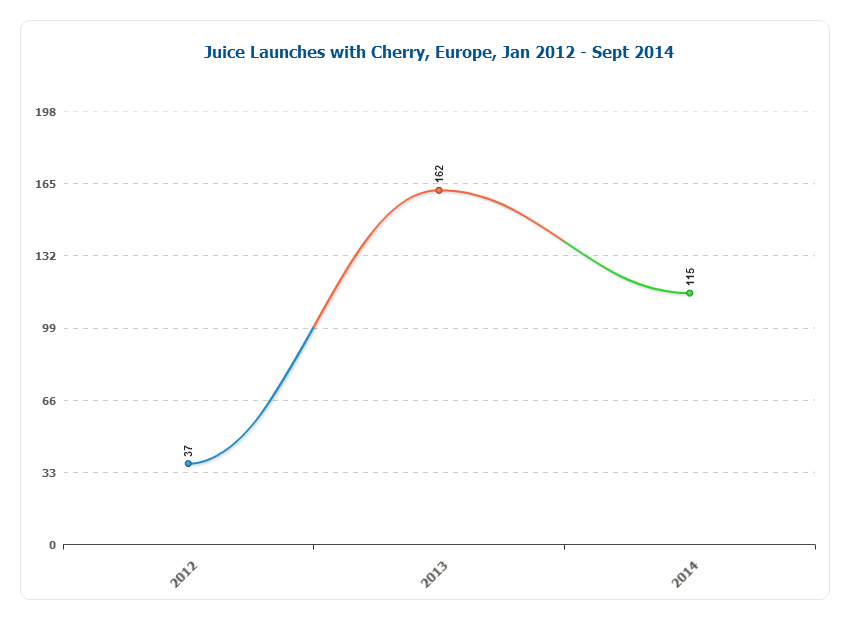News
Stage Set For New Stars in Superfruits
20 Oct 2014The long-held belief that fruit is good for you has increasingly come to the fore in recent years with rising promotion of its health benefits combined with generic industry efforts to encourage us to eat more. With this background, plus rising globalisation and an increasing emphasis on the new and unusual, it is interesting to […]

The long-held belief that fruit is good for you has increasingly come to the fore in recent years with rising promotion of its health benefits combined with generic industry efforts to encourage us to eat more. With this background, plus rising globalisation and an increasing emphasis on the new and unusual, it is interesting to see how the fruit market has developed in recent years, with the exotic becoming the everyday in many countries. Tropical fruits such as mango, guava, kiwi, lychee and passionfruit were once automatically regarded as exotic, but are now relatively standard fare, while for the new exotic we have to find other options, such as guanabana (soursop), seabuckthorn, prickly pear, baobab or jujube.
The term ‘superfruits’ has also entered the language, although controversy over what that means and/or whether it should be used at all continues to rage. Nonetheless, the rise of ‘superfruits’ has been increasingly in evidence over the past decade or so, with growing consumer awareness of the health benefits associated with their high antioxidant contents helping to drive activity. This has brought many hitherto little known fruits into the mainstream market for the first time, often for use as ingredients and flavourings in a wide range of food and drinks products.
Pomegranate was one of the first arrivals and has probably been one of the fruits most widely associated with the ‘superfruits’ concept. It first emerged in this guise in Japan before becoming relatively standard there, and then appearing in the US before moving on to Europe. It was subsequently joined by lesser-known fruits such as goji, acai and mangosteen.
Berries have also moved into the mainstream and broadened their offerings; this is reflected in soft drinks flavours, where berry and summer fruits were used in a quarter of the juice and juice drink launches recorded by Innova Market Insights in the 12 months to the end of September 2014. Standards such as strawberries and raspberries have been joined by a raft of other berries, many actively promoting their health benefits. Cranberries and blueberries are now well established, and are being joined by other varietals, many of them seasonal and/or regional, such as blackberries, chokeberries, elderberries, lingonberries and cloudberries.
Cherries have also seen rising levels of interest, aided by a growing body of evidence about their health benefits, and are now squarely in the frame for ‘superfruit’ status. They are also increasingly being used in juices and juice drink blends. Although they are not among the top fruits used in juice drink introductions, with orange and apple still dominating globally, ahead of mango and grape, they did feature in about 7% of the juice and juice drink launches recorded by Innova Market Insights. There is also a rising emphasis on differentiating cherry types, not just sour/tart or sweet, or black or red, but also specific varieties such as Montmorency, Amarena and Morello.
 It is clear that the fruit market is changing before our eyes, with the subsequent influence on industrial ingredient usage, particularly in soft drinks. It is difficult to predict where the new success stories will come from, but what is almost inescapable is that there will continue to be new and established varieties put forward as ‘the next big thing,’ although the ability to supply the larger quantities needed if they are taken up, and to market their multiple benefits successfully in competition with existing lines, will be critical to their success.
It is clear that the fruit market is changing before our eyes, with the subsequent influence on industrial ingredient usage, particularly in soft drinks. It is difficult to predict where the new success stories will come from, but what is almost inescapable is that there will continue to be new and established varieties put forward as ‘the next big thing,’ although the ability to supply the larger quantities needed if they are taken up, and to market their multiple benefits successfully in competition with existing lines, will be critical to their success.
Related news

Our most-read articles of 2025
23 Dec 2025
From trade tariffs to heavy metals in protein, we look back at some of the industry’s highlights of 2025 and round up our most-read stories of the year.
Read more
Bigging up bean-based products and consumption in Britain
19 Dec 2025
Non-profit organisation the Food Foundation has launched a campaign, “Bang in Some Beans”, designed to increase UK consumers’ legume consumption.
Read more
Ingredient transparency key to success in European natural health market
12 Dec 2025
Europe’s $40.7 billion supplements market is growing fast, fuelled by demand for products that support healthy ageing, mental wellbeing, and preventive health, say experts.
Read more
Whole Foods Market forecasts fibre frenzy for 2026
11 Dec 2025
Whole Foods Market has released its top 2026 trends, predicting that a fibre frenzy will take place next year as health-conscious consumers seek out nutritious, filling options.
Read more
Sorghum emerges as better-for-you hero ingredient
9 Dec 2025
With the launch of Novak Djokovic’s sorghum-based brand, the grain’s popularity in the better-for-you snacking sphere is on the rise, thanks to its nutritional and sensory properties.
Read more
Innovation promise in 'maturing' plant-based dairy alternatives market
8 Dec 2025
Plant-based dairy is a maturing market that still faces significant hurdles around taste, functionality, nutrition, and price, but industry is innovating fast, according to experts speaking at Fi Europe.
Read more
Celebrating the winners of the Fi Europe Innovation Awards 2025
3 Dec 2025
Food industry stakeholders celebrated as the winners of the Fi Europe Innovation Awards were announced at a ceremony in Paris.
Read more
Apply now for the Vitafoods Europe Innovation Awards 2026!
28 Nov 2025
Entries for the Vitafoods Europe Innovation Awards 2026 are now open! Game-changing companies have until 27 February to submit their entry across eight categories for the chance to win big.
Read more
Concerns swirl around cinnamon’s compliance with EU law
25 Nov 2025
Cinnamon may be a top functional ingredient, but it needs stronger protocols to ensure it meets EU food safety laws and quality standards, say researchers.
Read more
Bone broth: From old-fashioned to en vogue
24 Nov 2025
OXO’s entry into bone broth has turned the spotlight on this small but high-performance category – and there is still scope for growth, especially in the area of GLP-1 support.
Read more